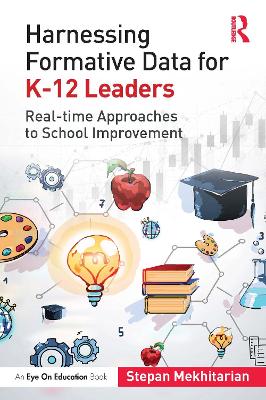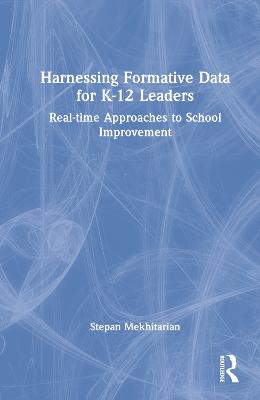Harnessing Formative Data for K-12 Leaders
 portes grátis
portes grátis
Harnessing Formative Data for K-12 Leaders
Real-time Approaches to School Improvement
Mekhitarian, Stepan
Taylor & Francis Ltd
10/2022
134
Mole
Inglês
9781032156682
15 a 20 dias
Descrição não disponível.
Foreword by Jason Green and Tiffany Wycoff
Preface
Acknowledgements
About the Author
Part I: The Need to Reevaluate How We Use Data in Our Organizations
Introduction: Changing Data Considerations
Advancements in Technology Changing Formative Data Use
Loss of Consistent Summative Data from Previous Academic Years
Concerns about Data Reliability Due to Limited Measures
Chapter 1: Your Organizations' Vision and Beliefs
Assessing Your Organization's Vision
Reflecting on Your Beliefs About Student Learning and Your Role
Where Formative Data Fits In
Key Takeaways
Chapter 2: The Impact of Formative Data on Student Success
Formative Data Fosters Educators' Growth Mindset
Formative Data Informs Planning and Focus Areas
Formative Data Facilitates Differentiation and Promotes Equity
Key Takeaways
Part II: Effective Formative Data Use for Leaders
Chapter 3: Effective Formative Data Use to Drive Organizational Change
How Actionable is the Data You Are Gathering?
How Timely is the Data You Are Gathering?
How Much Data Do You Need?
How much time will it take to collect the data and will you be able to address all the data you collect?
List data points to inform progress on:
Key Takeaways
Chapter 4: Using Instructional Technology to Effectively Address Formative Data
Using your SIS, Excel and Instructional Technology such as Illuminate to Efficiently Gather Formative Data
Identifying and Addressing Validation Concerns to Ensure Broader Impact
Implementing a Collaborative Plan-Do-Study-Act Cycle to Address Data
Key Takeaways
Chapter 5: Analyzing Formative Data Collaboratively to Identify and Celebrate Best Practices
PLCs using the PDSA cycle
Peer Observations - in-person and virtual
Professional Development linked to formative data page
Including a wide variety of departments to maximize perspective and expertise
Key Takeaways
Chapter 6: Building a Data-Driven Culture of Innovation
Re-envisioning Professional Development on Formative Data for All Educators
Reflecting on the Focus on Summative and Formative Data
Fostering a Data-Driven Organizational Culture
Conclusion
References
Index
Preface
Acknowledgements
About the Author
Part I: The Need to Reevaluate How We Use Data in Our Organizations
Introduction: Changing Data Considerations
Advancements in Technology Changing Formative Data Use
Loss of Consistent Summative Data from Previous Academic Years
Concerns about Data Reliability Due to Limited Measures
Chapter 1: Your Organizations' Vision and Beliefs
Assessing Your Organization's Vision
Reflecting on Your Beliefs About Student Learning and Your Role
Where Formative Data Fits In
Key Takeaways
Chapter 2: The Impact of Formative Data on Student Success
Formative Data Fosters Educators' Growth Mindset
Formative Data Informs Planning and Focus Areas
Formative Data Facilitates Differentiation and Promotes Equity
Key Takeaways
Part II: Effective Formative Data Use for Leaders
Chapter 3: Effective Formative Data Use to Drive Organizational Change
How Actionable is the Data You Are Gathering?
How Timely is the Data You Are Gathering?
How Much Data Do You Need?
How much time will it take to collect the data and will you be able to address all the data you collect?
List data points to inform progress on:
Key Takeaways
Chapter 4: Using Instructional Technology to Effectively Address Formative Data
Using your SIS, Excel and Instructional Technology such as Illuminate to Efficiently Gather Formative Data
Identifying and Addressing Validation Concerns to Ensure Broader Impact
Implementing a Collaborative Plan-Do-Study-Act Cycle to Address Data
Key Takeaways
Chapter 5: Analyzing Formative Data Collaboratively to Identify and Celebrate Best Practices
PLCs using the PDSA cycle
Peer Observations - in-person and virtual
Professional Development linked to formative data page
Including a wide variety of departments to maximize perspective and expertise
Key Takeaways
Chapter 6: Building a Data-Driven Culture of Innovation
Re-envisioning Professional Development on Formative Data for All Educators
Reflecting on the Focus on Summative and Formative Data
Fostering a Data-Driven Organizational Culture
Conclusion
References
Index
Este título pertence ao(s) assunto(s) indicados(s). Para ver outros títulos clique no assunto desejado.
Formative Data;Professional Development;Timeline;Data;Growth Mindset;Formative Data System;PLC;PDSA Cycle;Formative Data Analysis;Tech Tip;Maximizing Student Achievement;Chronic;Wo;PDSA;Summative Data;Data Points;Previous Academic Years;Team's Approach;Organizational Vision;Student Information System;Data Review Meetings;Lifelong Independent Learners;Uploading;Follow;State Dashboard
Foreword by Jason Green and Tiffany Wycoff
Preface
Acknowledgements
About the Author
Part I: The Need to Reevaluate How We Use Data in Our Organizations
Introduction: Changing Data Considerations
Advancements in Technology Changing Formative Data Use
Loss of Consistent Summative Data from Previous Academic Years
Concerns about Data Reliability Due to Limited Measures
Chapter 1: Your Organizations' Vision and Beliefs
Assessing Your Organization's Vision
Reflecting on Your Beliefs About Student Learning and Your Role
Where Formative Data Fits In
Key Takeaways
Chapter 2: The Impact of Formative Data on Student Success
Formative Data Fosters Educators' Growth Mindset
Formative Data Informs Planning and Focus Areas
Formative Data Facilitates Differentiation and Promotes Equity
Key Takeaways
Part II: Effective Formative Data Use for Leaders
Chapter 3: Effective Formative Data Use to Drive Organizational Change
How Actionable is the Data You Are Gathering?
How Timely is the Data You Are Gathering?
How Much Data Do You Need?
How much time will it take to collect the data and will you be able to address all the data you collect?
List data points to inform progress on:
Key Takeaways
Chapter 4: Using Instructional Technology to Effectively Address Formative Data
Using your SIS, Excel and Instructional Technology such as Illuminate to Efficiently Gather Formative Data
Identifying and Addressing Validation Concerns to Ensure Broader Impact
Implementing a Collaborative Plan-Do-Study-Act Cycle to Address Data
Key Takeaways
Chapter 5: Analyzing Formative Data Collaboratively to Identify and Celebrate Best Practices
PLCs using the PDSA cycle
Peer Observations - in-person and virtual
Professional Development linked to formative data page
Including a wide variety of departments to maximize perspective and expertise
Key Takeaways
Chapter 6: Building a Data-Driven Culture of Innovation
Re-envisioning Professional Development on Formative Data for All Educators
Reflecting on the Focus on Summative and Formative Data
Fostering a Data-Driven Organizational Culture
Conclusion
References
Index
Preface
Acknowledgements
About the Author
Part I: The Need to Reevaluate How We Use Data in Our Organizations
Introduction: Changing Data Considerations
Advancements in Technology Changing Formative Data Use
Loss of Consistent Summative Data from Previous Academic Years
Concerns about Data Reliability Due to Limited Measures
Chapter 1: Your Organizations' Vision and Beliefs
Assessing Your Organization's Vision
Reflecting on Your Beliefs About Student Learning and Your Role
Where Formative Data Fits In
Key Takeaways
Chapter 2: The Impact of Formative Data on Student Success
Formative Data Fosters Educators' Growth Mindset
Formative Data Informs Planning and Focus Areas
Formative Data Facilitates Differentiation and Promotes Equity
Key Takeaways
Part II: Effective Formative Data Use for Leaders
Chapter 3: Effective Formative Data Use to Drive Organizational Change
How Actionable is the Data You Are Gathering?
How Timely is the Data You Are Gathering?
How Much Data Do You Need?
How much time will it take to collect the data and will you be able to address all the data you collect?
List data points to inform progress on:
Key Takeaways
Chapter 4: Using Instructional Technology to Effectively Address Formative Data
Using your SIS, Excel and Instructional Technology such as Illuminate to Efficiently Gather Formative Data
Identifying and Addressing Validation Concerns to Ensure Broader Impact
Implementing a Collaborative Plan-Do-Study-Act Cycle to Address Data
Key Takeaways
Chapter 5: Analyzing Formative Data Collaboratively to Identify and Celebrate Best Practices
PLCs using the PDSA cycle
Peer Observations - in-person and virtual
Professional Development linked to formative data page
Including a wide variety of departments to maximize perspective and expertise
Key Takeaways
Chapter 6: Building a Data-Driven Culture of Innovation
Re-envisioning Professional Development on Formative Data for All Educators
Reflecting on the Focus on Summative and Formative Data
Fostering a Data-Driven Organizational Culture
Conclusion
References
Index
Este título pertence ao(s) assunto(s) indicados(s). Para ver outros títulos clique no assunto desejado.
Formative Data;Professional Development;Timeline;Data;Growth Mindset;Formative Data System;PLC;PDSA Cycle;Formative Data Analysis;Tech Tip;Maximizing Student Achievement;Chronic;Wo;PDSA;Summative Data;Data Points;Previous Academic Years;Team's Approach;Organizational Vision;Student Information System;Data Review Meetings;Lifelong Independent Learners;Uploading;Follow;State Dashboard







